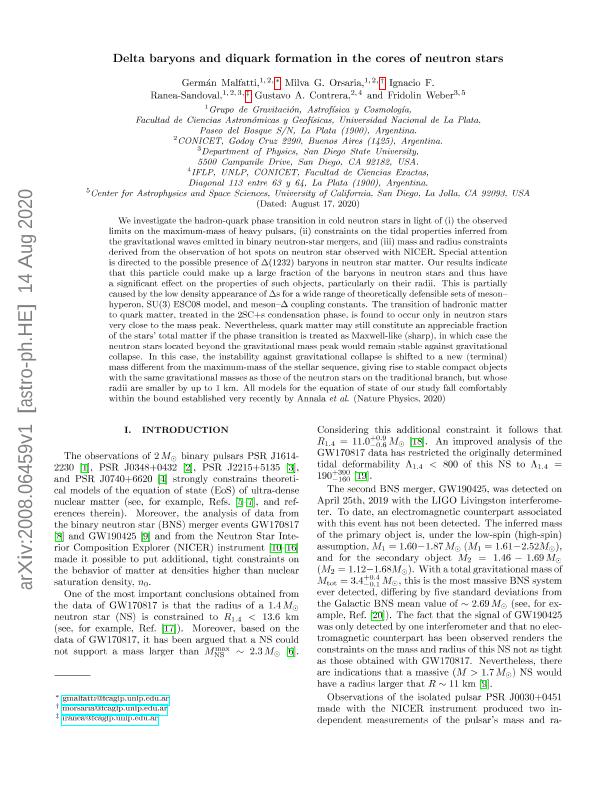Artículo
Delta baryons and diquark formation in the cores of neutron stars
Malfatti, Germán ; Orsaria, Milva Gabriela
; Orsaria, Milva Gabriela ; Ranea Sandoval, Ignacio Francisco
; Ranea Sandoval, Ignacio Francisco ; Contrera, Gustavo Aníbal Gabriel
; Contrera, Gustavo Aníbal Gabriel ; Weber, Fridolin
; Weber, Fridolin
 ; Orsaria, Milva Gabriela
; Orsaria, Milva Gabriela ; Ranea Sandoval, Ignacio Francisco
; Ranea Sandoval, Ignacio Francisco ; Contrera, Gustavo Aníbal Gabriel
; Contrera, Gustavo Aníbal Gabriel ; Weber, Fridolin
; Weber, Fridolin
Fecha de publicación:
09/09/2020
Editorial:
American Physical Society
Revista:
Physical Review D: Particles, Fields, Gravitation and Cosmology
ISSN:
2470-0010
e-ISSN:
2470-0029
Idioma:
Inglés
Tipo de recurso:
Artículo publicado
Clasificación temática:
Resumen
We investigate the hadron-quark phase transition in cold neutron stars in light of (i) the observed limits on the maximum-mass of heavy pulsars, (ii) constraints on the tidal properties inferred from the gravitational waves emitted in binary neutron-star mergers, and (iii) mass and radius constraints derived from the observation of hot spots on neutron star observed with the Neutron Star Interior Composition Explorer instrument. Special attention is directed to the possible presence of Δ(1232) baryons in neutron star matter. Our results indicate that this particle could make up a large fraction of the baryons in neutron stars and thus have a significant effect on the properties of such objects, particularly on their radii. This is partially caused by the low density appearance of Δs for a wide range of theoretically defensible sets of meson-hyperon, SU(3) ESC08 model, and meson-Δ coupling constants. The transition of hadronic matter to quark matter, treated in the 2SC+s condensation phase, is found to occur only in neutron stars very close to the mass peak. Nevertheless, quark matter may still constitute an appreciable fraction of the stars' total matter if the phase transition is treated as Maxwell-like (sharp), in which case the neutron stars located beyond the gravitational mass peak would remain stable against gravitational collapse. In this case, the instability against gravitational collapse is shifted to a new (terminal) mass different from the maximum-mass of the stellar sequence, giving rise to stable compact objects with the same gravitational masses as those of the neutron stars on the traditional branch, but whose radii are smaller by up to 1 km. All models for the equation of state of our study fall comfortably within the bound established very recently by Annala et al.
Palabras clave:
Neutron Stars
,
QCD phase transition
,
Hyperons
,
NJL model
Archivos asociados
Licencia
Identificadores
Colecciones
Articulos(CCT - LA PLATA)
Articulos de CTRO.CIENTIFICO TECNOL.CONICET - LA PLATA
Articulos de CTRO.CIENTIFICO TECNOL.CONICET - LA PLATA
Articulos(IFLP)
Articulos de INST.DE FISICA LA PLATA
Articulos de INST.DE FISICA LA PLATA
Citación
Malfatti, Germán; Orsaria, Milva Gabriela; Ranea Sandoval, Ignacio Francisco; Contrera, Gustavo Aníbal Gabriel; Weber, Fridolin; Delta baryons and diquark formation in the cores of neutron stars; American Physical Society; Physical Review D: Particles, Fields, Gravitation and Cosmology; 102; 6; 9-9-2020; 1-18
Compartir
Altmétricas



